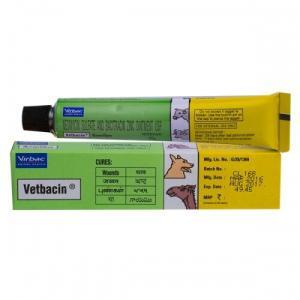Table of Contents
Vetbacin ointment is specifically designed for veterinary use and is recommended for treating various animal conditions. It is highly effective in dressing wounds, ulcers, cuts, abrasions, foot rot, udder impetigo, lesions caused by foot-and-mouth disease (FMD) in hooves, as well as postoperative lesions and burns.

What Is Vetbacin (Bacitracin Zinc, Neomycin Sulphate)?
Vetbacin is a veterinary medication that contains two active ingredients: bacitracin zinc and neomycin sulfate. It is commonly used in animals to prevent and treat bacterial infections.
What does bacitracin target, and what is bacitracin zinc? Bacitracin zinc is an antibiotic that works by inhibiting the growth of bacteria. It is primarily effective against Gram-positive bacteria, such as Staphylococcus and Streptococcus species. Bacitracin is commonly used as a topical ointment or cream to treat skin infections, wounds, and eye infections in animals.
Neomycin sulfate is also an antibiotic that interferes with the production of proteins in bacteria, thereby inhibiting their growth. Neomycin sulphate cream has a broader spectrum of activity and can be effective against both Gram-positive and Gram-negative bacteria. Neomycin is commonly used to treat gastrointestinal infections, such as enteritis or colitis, and is sometimes used topically in ear and eye infections.
Vetbacin, containing both bacitracin zinc and neomycin sulfate, combines these two antibiotics to target a wider range of bacterial infections in animals and a broader spectrum of activity. It is important to note that Vetbacin is intended for veterinary use only and should not be used in humans without proper medical supervision.
Ingredients in Bacitracin Ointment
Each gram contains:
- Neomycin Sulphate IP 5 mg;
- Bacitracin Zinc IP equivalent to Bacitracin 500 IU in a soft paraffin base.
The Bacitracin tube size is 20 g. Read the instruction label or ask a veterinarian about bacitracin structure if you need more detailed information.
Forms of the Active Ingredients
Bacitracin Zinc and Neomycin Sulphate are available in different forms for veterinary use.
Ointment
This formulation is designed for topical application. It is typically used for treating skin infections, wounds, ulcers, cuts, abrasions, and other external conditions in animals. The ointment is applied directly to the affected area. There is also bacitracin with lidocaine (bacitracin with pain relief) ointment.
Powder
Bacitracin Zinc and Neomycin Sulphate powder is used for various purposes, such as wound care and treating gastrointestinal infections in animals. It can be mixed with other substances or used as a dusting powder for wound management.
Injection
Bacitracin for injection is commonly used to treat systemic bacterial infections in animals. Bacitracin solution allows the medication to be directly delivered into the bloodstream, ensuring effective distribution throughout the body.
The specific form and dosage of Bacitracin Zinc and Neomycin Sulphate should be determined by a veterinarian based on the animal’s condition and treatment requirements.
Uses of Vetbacin
Many people ask: Does bacitracin kill MRSA and staph? And what is bacitracin zinc ointment used for? Let’s check the uses of the ointment.
Bacitracin ointment with zinc is indicated for use in various situations in animals where there is a need for topical treatment of bacterial infections or wound management. Pay attention that bacitracin without zinc provides another effect. Ask your veterinarian about the difference between bacitracin and bacitracin zinс ointment. Some common situations where Bacitracin ointment for MRSA may be used include:
- Wound Dressing: Bacitracin ointment aid can be applied to wounds, ulcers, cuts, and abrasions in animals to help prevent or treat bacterial infections. It helps cleanse the wounds and supports the healing process.
- Foot Rot: Foot rot is common in livestock, mainly sheep and cattle. Vetbacin ointment can be applied to the affected areas to help control bacterial infections and promote healing.
- Udder Impetigo: Udder impetigo, also known as mastitis, is an infection of the udder in dairy animals. Vetbacin ointment can manage udder impetigo to help control bacterial growth and facilitate healing.
- Postoperative Lesions: Animals may develop postoperative wounds or lesions after surgical procedures. Vetbacin ointment can be applied to these areas to prevent or treat bacterial infections and aid in the healing process.
- Burns: In cases of burns, Vetbacin ointment can provide topical treatment to help prevent secondary bacterial infections and support the healing of damaged skin.
Consult a veterinarian for a proper diagnosis and guidance on the appropriate use of bacitracin zinc for cats and dogs, as well as for other animals.
Who Can Use the Ointment?
This ointment can be used on various animals, including farm animals, dogs, horses, and cats. Vetbacin ointment is specifically formulated for veterinary use and should only be used under the guidance and prescription of a veterinarian.
Medicine for Farm Animals
This includes livestock such as cattle, sheep, goats, and pigs. Vetbacin ointment can be used in farm animals to treat wounds, ulcers, cuts, abrasions, foot rot, udder impetigo, and postoperative lesions. Bacitracin ointment is a first-aid antibiotic to prevent or treat bacitracin-sensitive bacteria and promotes healing in these animals.
Vetbacin for Dogs
People ask: Can I use bacitracin zinc ointment on my dog?
Bacitracin zinc ointment for dogs can treat skin infections, wounds, cuts, and abrasions. It helps in managing bacterial infections and supports the healing process in dogs. However, it’s essential to consult a veterinarian for proper diagnosis and guidance on using this medication in dogs.
Bacitracin Zinc, Neomycin Sulphate for Horses
Horses can benefit from Vetbacin ointment to treat wounds, ulcers, cuts, and abrasions. It can help in managing bacterial infections and promoting healing in horses. Veterinary consultation is recommended to determine the appropriate use of Vetbacin ointment in horses.

Ointment for Cats
Vetbacin ointment can be used in cats to treat skin infections, wounds, cuts, and abrasions. However, it’s crucial to consult a veterinarian before using the medication on cats, as cats may have different sensitivities and requirements than other animals.
Proper diagnosis and veterinary guidance are essential before using this or any other animal medication.
Dosage Sizes
How often to apply bacitracin?
The specific bacitracin ointment dose for cats, dogs, horses, and cattle can vary based on the animal’s weight, treated condition, the severity of the infection, and the veterinarian’s recommendation. Consult a veterinarian who can assess your animal’s needs and provide accurate bacitracin dosage instructions.
The veterinarian will determine the appropriate dosage size for cats based on factors such as the affected area’s size and the infection’s severity. Cats may require a smaller amount of ointment compared to larger animals.
Like cats, the dosage size for dogs will depend on factors like the size of the affected area and the severity of the condition. Dogs may require a larger dosage than cats, but the veterinarian will determine this.
Horses generally have larger surface areas to treat compared to smaller animals. The veterinarian will determine the appropriate dosage size based on the extent and severity of the condition being treated.
Cattle, being larger animals, may require a larger dosage of Vetbacin ointment. The veterinarian will assess the condition and provide specific dosage sizes and frequency instructions.
Important Safety Information for Owners
Vetbacin should only be used under the guidance and prescription of a veterinarian. They will determine if Vetbacin is appropriate for your animal’s condition and provide proper dosage instructions.
Some animals may be sensitive or allergic to the ingredients in Vetbacin. If you observe any signs of an allergy to bacitracin, such as rash, swelling, or difficulty breathing, discontinue use immediately and seek veterinary attention.
Vetbacin ointment is designed for topical use and should not be ingested by the animal. Ensure that your animal cannot lick or ingest the ointment after application.
While uncommon, some animals may experience adverse reactions to the ointment. If you notice any unusual or concerning symptoms after using it, such as severe irritation, redness, or worsening of the condition, contact your veterinarian.
It is important to schedule follow-up visits with your veterinarian to monitor the progress of the treatment and make any necessary adjustments.
Veterinary Prescription
In most countries, Vetbacin ointment typically requires a veterinary prescription to purchase. It is a medication specifically formulated for veterinary use and should be obtained through a licensed veterinarian. The prescription ensures that the medication is used appropriately and per the specific needs of the animal being treated.
To obtain Vetbacin ointment, you must consult a veterinarian who will assess your animal’s condition, provide a diagnosis, and determine if Vetbacin is the appropriate treatment option.
Where can I buy bacitracin ointment?
Check bacitracin cost and bacitracin ointment price and buy neomycin sulphate+bacitracin ointment at an online pharmacy.
Contraindications
Here are some general bacitracin contraindications:
- If an animal has a known hypersensitivity or allergy to any active ingredients in Vetbacin ointment (bacitracin zinc or neomycin sulfate), its use should be avoided.
- In some cases, deep or extensive wounds may require a different treatment approach, such as surgical intervention or systemic antibiotics, rather than topical ointments alone. Your veterinarian will assess the wound and determine the most appropriate course of treatment.
- In certain situations, such as large open wounds or severe burns, there may be a risk of excessive systemic absorption of the active ingredients in Vetbacin ointment. This can lead to potential adverse effects. Your veterinarian will evaluate the specific condition and determine the appropriate treatment approach.
- Animals with pre-existing medical conditions, such as kidney or liver disease, may require caution or dose adjustments when using Vetbacin ointment. Provide a detailed medical history to the veterinarian to ensure the safe and appropriate use of the medication for dogs, cats, and other animals.
These are general contraindications that might apply to antibiotic ointments, but the specific contraindications for Vetbacin ointment can vary.
Side Effects
Vetbacin ointment, containing bacitracin zinc and neomycin sulfate, may have potential side effects, although they are not commonly reported. Individual animals may react differently, and the occurrence and severity of bacitracin side effects can vary. Here are some potential side effects associated with Vetbacin ointment:
- Some animals may experience local irritation or allergic reactions at the application site, such as redness, swelling, itching, or rash. If these symptoms occur, discontinue use and seek veterinary advice.
- Although rare, the ointment’s active ingredients can be absorbed systemically, leading to systemic effects, particularly if large amounts are applied to a significant area of the skin. This can include adverse effects such as nephrotoxicity (kidney damage) or neurotoxicity (nervous system effects). These effects are more likely to occur with prolonged or excessive use.
- Some animals may develop hypersensitivity or allergic reactions to the ingredients in Vetbacin ointment. Signs may include swelling of the face, lips, or tongue, difficulty breathing, or generalized itching. If any of these symptoms occur, discontinue use and seek immediate veterinary attention.
This is not an exhaustive list of side effects; other rare or uncommon side effects may be associated with the ointment.

Overdose
An overdose of this medication can occur if it is applied in excessive amounts or used for an extended duration beyond the recommended guidelines. Follow the veterinarian’s instructions regarding the dosage and duration of treatment to prevent potential complications. However, if an overdose does occur or you suspect that your animal has been exposed to excessive Vetbacin ointment, it is essential to seek veterinary attention immediately.
Overdose of the ointment may lead to increased absorption of the active ingredients, potentially causing systemic effects and adverse reactions. These effects can vary depending on the individual animal, the overdose amount, and the exposure duration. Symptoms of an overdose may include increased skin irritation, redness, swelling, or other signs of hypersensitivity.
When seeking veterinary assistance for an overdose, be prepared to provide information about the animal’s weight, the amount and frequency of Vetbacin applied, and the time of exposure. The veterinarian will assess the situation, provide appropriate treatment, and take necessary steps to minimize potential harm.
If you have concerns about the proper use of the ointment or suspect an overdose has occurred, contact a veterinarian immediately for advice and assistance.
Vetbacin Poisoning
If you suspect that your animal has been poisoned by this medication or your dog ate bacitracin, it is crucial to seek immediate veterinary assistance. Vetbacin poisoning can occur if the ointment is ingested orally or if an excessive amount is absorbed through the skin or mucous membranes.
Call a veterinarian or an emergency veterinary clinic immediately and explain the situation. Provide information about the animal’s species, size, the amount and route of exposure to Vetbacin, and any observed symptoms. The veterinarian will provide specific instructions based on the animal’s condition and the suspected poisoning. Follow their guidance carefully and do not attempt treatments or induce vomiting without professional advice.
Watch for any signs of poisoning, which may vary depending on the animal and the amount of Vetbacin ingested or absorbed. Symptoms may include gastrointestinal distress (vomiting, diarrhea), neurological effects (tremors, seizures), difficulty breathing, or signs of an allergic reaction (swelling, hives). Take note of any observed symptoms to provide accurate information to the veterinarian.
Time is critical in cases of suspected poisoning. Do not delay seeking veterinary assistance if you suspect Vetbacin poisoning.
Storage
It should be stored in a cool, dry place away from direct sunlight, excessive heat, and moisture. Avoid storing it in areas prone to temperature fluctuations, such as near windows or heaters. Ensure the lid or cap of the ointment container is tightly closed when not in use. This helps prevent moisture or contaminants from entering the container and affecting the ointment’s quality. Store Vetbacin in a secure location that is inaccessible to children and animals. This prevents accidental ingestion or misuse of the medication. Store the ointment separately from food items, beverages, and household products to avoid cross-contamination.
Generic and Brand Names of Vetbacin (Bacitracin Zinc, Neomycin Sulphate)
Vetbacin is a proprietary brand name for a medication that contains the active ingredients bacitracin zinc and neomycin sulfate. These active ingredients are also available under different generic and brand names. Here are some examples:
Generic Names
- Bacitracin Zinc and Neomycin Sulphate Ointment
- Bacitracin Zinc/Neomycin Sulphate Topical
- Bacitracin/Neomycin Ointment
- Bacitracin Plus Ointment
Brand Names
- VetBac
- Bacibact
- Bacisun
- Bacisept
- Neobacitracin
- Neomycin-Bacitracin
- Neo-Polycin
The availability of specific brand names may vary depending on your location and the manufacturer.
Other Drugs in the Same Class
Vetbacin (bacitracin zinc and neomycin sulfate) belongs to a class of medications known as topical antibiotics. These antibiotics are commonly used in veterinary medicine for their antibacterial properties. Here are some other drugs in the same class as Vetbacin:
- Triple Antibiotic Ointment: This is a combination of three antibiotics, including bacitracin zinc, neomycin, and polymyxin B. It is commonly used to treat minor cuts, burns, and skin infections in humans and animals or in polymyxin bacitracin ophthalmic ointment.
- Polymyxin B: Polymyxin B is an antibiotic in the polymyxin class. It is often used with other antibiotics for its broad-spectrum activity against various bacteria. It is available in topical formulations for veterinary use.
- Gentamicin: Gentamicin is an antibiotic that belongs to the aminoglycoside class. It is commonly used in veterinary medicine to treat bacterial infections, including skin and ear infections. It is available in various formulations, including topical ointments.
- Mupirocin: Mupirocin is a topical antibiotic used to treat bacterial skin infections, including those caused by methicillin-resistant Staphylococcus aureus (MRSA). It is commonly used in both human and veterinary medicine.
- Silver Sulfadiazine: Silver sulfadiazine is a topical antibiotic cream that combines a sulfonamide antibiotic (sulfadiazine) with silver ions. It is commonly used to treat burns and other wounds to prevent or treat bacterial infections.
These drugs are not bacitracin alternatives. They may have different formulations, concentrations, and specific uses. The choice of antibiotic medication will depend on the specific condition being treated and the veterinarian’s recommendation based on the causative bacteria and their susceptibility. Always consult a veterinarian for the appropriate selection and use of antibiotics in veterinary medicine.
Comparing Bacitracin Zinc to other Active Ingredients and Ointments
Check the table comparing Bacitracin Zinc to other active ingredients commonly found in topical antibiotic medications.
|
Active Ingredient |
Brand Names |
Common Uses |
Spectrum of Activity |
Administration |
|
Bacitracin Zinc |
Bacitracin and Bacitracin Zinc Ointment |
Wound healing, skin infections |
Gram-positive bacteria |
Topical application |
|
Neomycin Sulfate (bacitracin zinc ointment vs neosporin) |
Neosporin |
Wound healing, skin infections |
Broad-spectrum |
Topical application |
|
Benzalkonium Chloride (bactine vs bacitracin) |
Bactine |
Wound cleansing, minor cuts and scrapes |
Gram-positive bacteria |
Topical application |
|
Polymyxin B Sulfate (bacitracin zinc and polymyxin b sulfate ointment) |
Polymyxin B Sulfate Ointment |
Skin infections, eye infections |
Gram-negative bacteria |
Topical or ophthalmic use |
|
Mupirocin (mupirocin ointment vs bacitracin) |
Mupirocin |
Skin infections, impetigo, MRSA infections |
Gram-positive bacteria |
Topical application |
|
Mupirocin Calcium |
Bactroban |
Skin infections, impetigo, MRSA infections |
Gram-positive bacteria |
Topical application or nasal use |
Please note that this table is for general informational purposes and may not include all brand names or uses associated with each active ingredient.
FAQ
How Long to Use Bacitracin?
The duration of Bacitracin use depends on the specific condition being treated and the advice of a healthcare professional or veterinarian. Generally, Bacitracin is applied topically to the affected area two to three times a day until the wound or infection improves. Follow the instructions provided by your veterinarian and complete the entire course of treatment.
How Does Bacitracin Kill Bacteria?
Bacitracin’s mechanism of action includes interfering with the synthesis of bacterial cell walls. It inhibits the formation of peptidoglycan, a crucial component of bacterial cell walls. By disrupting cell wall formation, Bacitracin weakens and ultimately kills susceptible bacteria. Sometimes veterinarians prescribe bacitracin susceptibility tests.
What If My Dog Licks the Ointment?
If your dog licks the Bacitracin ointment, it is generally considered safe. However, excessive licking or ingesting large amounts may cause stomach upset or other mild gastrointestinal symptoms. Preventing your dog from licking the ointment excessively by using an Elizabethan collar or monitoring their behavior closely during the healing process is advisable.
Is It OK to Use Expired Bacitracin?
Using expired Bacitracin is not recommended. Expired medications may have reduced effectiveness or may be contaminated, increasing the risk of adverse reactions. It is best to discard and replace any expired medications, including Bacitracin.

































